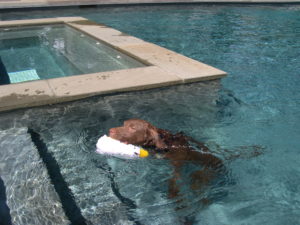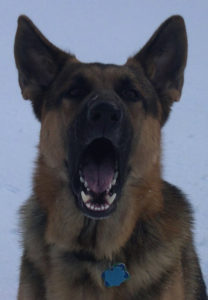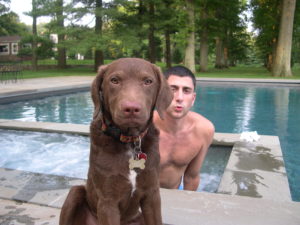![]()
quick bites
Behavior

Dogs are opportunistic.
If the consequence is good, dogs will tend to repeat a behavior. If the consequence is unpleasant, dogs will eventually stop doing the behavior. Dogs are learning all the time, either from us, other dogs, or from their environment. It helps to ‘dog proof’ your house so that your dog doesn’t get inadvertently reinforced by his environment. If he succeeds once, he will try again. Teach your dog that pleasing you is the fastest way to get what he wants.
Stopping Unwanted Behaviors 101:
First, teach your dog what you want him to do instead of the unwanted behavior. Then make sure your dog doesn’t get reinforced if he does the unwanted behavior.

A tired dog is a good dog.
All dogs need some form of mental and physical stimulation every day, at least twice daily — throughout their lives. Dogs are most active in the morning and late afternoon/early evening. The best strategy is to schedule fun activities (like walks, hikes, ball games, training,) every morning to start the day right and tire your dog out. Then he’ll be content when you leave the house or sit down to work. Plan to do this again later in the day.
 When your dog barks, he’s trying to tell you something.
When your dog barks, he’s trying to tell you something.
Dogs bark for many reasons: alerting their pack of imminent danger, boredom, fear or requesting something (to go outside, to eat, attention.) To stop the barking, you must discover its root cause and remove your dog’s motivation for barking. If, for instance, when your dog barks at something outside, you yell at him to stop, he may think that you’re barking with him, which might cause him to bark even more. To stop the barking, you must demonstrate that you understand what he was trying to tell you, and reassure him that you have it under control. Next time, try getting up and investigating by looking out the window; thank your dog for doing a good job, and bring him into another room to lie down next to you. In this way, you have done your job as a leader who protects the territory and everyone inside it.
A good habit is as hard to break as a bad habit.
Dogs, like humans, quickly form habits, good and bad. We often try to break our bad habits and it’s not easy to do. Dogs, on the other hand, have no desire to change so it will take time, effort and consistency on our part to stop our dog’s old behaviors and form new ones – usually about three weeks. The longer your dog has been practicing the behavior, the longer it may take. That’s why It’s much easier to supervise your dog from the outset, and interrupt unwanted behaviors before they become habitual.
A quick way to get your dog to love your toddler: Allow her to drop food from her highchair.
But be sure to supervise all interactions between your child and dog; many of the problems arise because children are unpredictable and make dogs afraid. It’s important to learn your dog’s body language so you can recognize his stress signals and warning signs: tongue flicks, yawns, avoidance, growling. A few important guidelines: Don’t allow your children to disturb a dog when he’s eating or sleeping. Don’t allow your child to discipline your dog or take something away from him. Give your dog a safe place to go where he can escape from your child. Make sure your dog gets plenty of exercise and play to help relieve stress and pent up energy. Teach your dog basic obedience skills: sit, down, stay, come.
Behavior never stays the same.
It tends to get better or worse, depending on your dog’s environment, time, and what you do about it.

Model good behavior:
Dogs have emotions, just like humans do. Dogs feel sad, happy, worried, fearful, angry, and they anticipate good things and bad things. Like children, they respond to our moods and behavior. If your tone is calm and soothing, your dog will relax. If you yell, your dog will become more agitated. Good leaders are calm, self-assured and patient. Poor leaders are harsh, insecure and intimidating.
A Spoonful of sugar helps the medicine go down:
If you give your dog treats during unpleasant experiences — like cleaning his ears, giving him medicine or going to the veterinary office — he probably won’t mind as much, and might even welcome them.
Space is sacred:
Dogs are protective about the space around them. If you move into a dog’s space, he will tend to back away from you. Dogs lie in proximity to those they love and avoid contact with whomever they fear or dislike – people or animals. While humans greet by directly entering into each other’s space to shake hands or hug, dogs greet each other by circling in an arc and briefly sniffing each other’s rear end. In the canine world, it’s considered rude and controlling behavior for one dog to put his paw on another dog’s back or hover over him. Although dogs learn to tolerate hugging and pats on the head from people they love, they don’t necessarily like it. When greeting a strange dog, it’s best to stand still with your arms at your side. Don’t reach into the dog’s space to pet him. It’s safer and more respectful to allow the dog to investigate you at his own pace.
Fear controls the dog. The dog can’t control his fear.
Trish King
When a dog is afraid or anxious, his chemistry changes as cortisol floods his system. He can’t think or respond to his owner. Instead, he will freeze, fight or flee, depending on his temperament and the situation. To help your dog cope with his fears, you need to change your dog’s environment or change what you’re doing. In general, owners should limit their dog’s exposure to fear-inducing situations.
